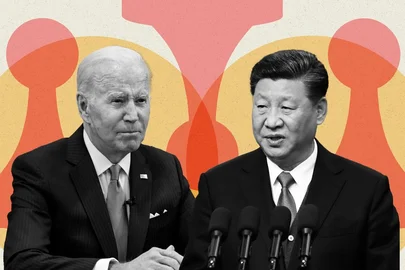On June 19, China and the United States engaged in two very different missile launches. But both were meant to serve the same objective—of gaining a psychological edge over the other in a long contest for global ascendancy.
On the fateful Sunday, the US Strategic Command confirmed that the US Navy's "Ohio"-class strategic nuclear submarine had successfully launched four Trident II D5 intercontinental ballistic missiles. The launches were carried out in the waters west of California. The missiles hit their targets in the Pacific region accurately.
The navigational warning for surface shipping that the US military had issued ahead of launches revealed that the missiles flew across most of the Pacific Ocean, and ended up in the waters near Guam, a top US military base in the Indo-Pacific.
But before the sun had gone down, the Chinese Ministry of National Defence announced that Beijing had successfully carried out a land based anti- ballistic missile test meant to destroy an in-coming missile during its mid-course. The message to the Washington was clear—China was not intimidated, but prepared to counter a US nuclear missile strike.
Acquiring the capability to cause mid-course destruction is important for two reasons. First, it is difficult to destroy a missile in its initial boost phase as, during this stage the weapon is being fired from areas located in depth, which are hard to target. Destroying a nuclear tipped missile in its terminal phase is also not desirable as it poses significant radiation risks. Besides, as countries begin to transition to very high- speed hypersonic missile, the chances of missing the incoming weapon in its terminal phase has increased.
The difficulties for last stage interception have only increased as many countries are developing hypersonic missiles with wave-rider gliders. Hypersonic missiles with this technology can adjust their flight path once they re-enter the atmosphere, making it hard to knock them down.
Unsurprisingly, the Chinese have been, since 2010, focusing on destroying hostile missiles during their mid-course flight.
In developing an Anti-Ballistic Missile (ABM) with mid-course kill, the Chinese seem to be working on three aspects. First, they appear to be ensuring that the missile warhead is adequately lightweight, so that the missile can travel faster towards its target, without compromising its precision. Second they would have to develop a rapid combustion rocket in order to gather the required speed. Third, a network of satellites and radars would be required in order to acquire the target.
The Chinese publication, Global Times is reporting that the US is spending $100 billion on its Ground Based Strategic Deterrent programme. The US Air Force is also working on LGM-35A Sentinel—its next generation Intercontinental Ballistic Missile (ICBM) which will replace the aging Minuteman III from 2029 onwards. ICBMs have a target range anywhere between 5000-12000 kilometers.
Besides, the Chinese fear that the US is working on a new generation of less than 5000 kilometer range Intermediate Range Ballistic Missiles (IRBMs) for deployment in the First Island Chain, which encircles China.
The lengthy first island chain starts from Kamchatka peninsula in Russia’s Far East and weaves its way into Japan. Then, from the southernmost part of the Japanese mainland, it passes through Okinawa, a part of a larger Ryukyu island chain which ends with Taiwan. From Taiwan, the “first island chain” heads towards the Philippines and the island of Borneo, before looping towards the tip of the Malay Peninsula. After the collapse of the Soviet Union, the first island chain has begun to increasingly focus on China.
MAP BREAK
You are going to be hearing the phrases First Island Chain and Second Island Chain a lot so here they are
1st: Taiwan, Okinawa, Philippines
2nd: Guam pic.twitter.com/Qyuq4o3m7z— Jack Posobiec
(@JackPosobiec) August 17, 2021
For India, the lessons of the US-China shadow boxing over missile dominance are clear. In order to defeat Chinese missile defences, India must rapidly develop a first-rate hypersonic missile arsenal, with wave-rider gliders. Besides, in order to deploy an efficient deterrent, New Delhi’s task is cut out—of developing a reliable arsenal of ABMs that can destroy incoming missiles during their mid-course.
Also Read: China’s Xi Jinping draws new military leadership line up for his third term in office




















